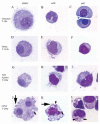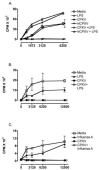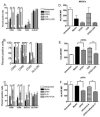Cowpox virus inhibits human dendritic cell immune function by nonlethal, nonproductive infection
- PMID: 21334039
- PMCID: PMC3694803
- DOI: 10.1016/j.virol.2011.01.024
Cowpox virus inhibits human dendritic cell immune function by nonlethal, nonproductive infection
Abstract
Orthopoxviruses encode multiple proteins that modulate host immune responses. We determined whether cowpox virus (CPXV), a representative orthopoxvirus, modulated innate and acquired immune functions of human primary myeloid DCs and plasmacytoid DCs and monocyte-derived DCs (MDDCs). A CPXV infection of DCs at a multiplicity of infection of 10 was nonproductive, altered cellular morphology, and failed to reduce cell viability. A CPXV infection of DCs did not stimulate cytokine or chemokine secretion directly, but suppressed toll-like receptor (TLR) agonist-induced cytokine secretion and a DC-stimulated mixed leukocyte reaction (MLR). LPS-stimulated NF-κB nuclear translocation and host cytokine gene transcription were suppressed in CPXV-infected MDDCs. Early viral immunomodulatory genes were upregulated in MDDCs, consistent with early DC immunosuppression via synthesis of intracellular viral proteins. We conclude that a nonproductive CPXV infection suppressed DC immune function by synthesizing early intracellular viral proteins that suppressed DC signaling pathways.
Copyright © 2011 Elsevier Inc. All rights reserved.
Figures







Similar articles
-
Modulation of the host immune response by cowpox virus.Microbes Infect. 2010 Nov;12(12-13):900-9. doi: 10.1016/j.micinf.2010.07.007. Epub 2010 Jul 29. Microbes Infect. 2010. PMID: 20673807 Free PMC article. Review.
-
Effects of Filovirus Interferon Antagonists on Responses of Human Monocyte-Derived Dendritic Cells to RNA Virus Infection.J Virol. 2016 Apr 29;90(10):5108-5118. doi: 10.1128/JVI.00191-16. Print 2016 May 15. J Virol. 2016. PMID: 26962215 Free PMC article.
-
IL-21 enhances SOCS gene expression and inhibits LPS-induced cytokine production in human monocyte-derived dendritic cells.J Leukoc Biol. 2006 Jun;79(6):1279-85. doi: 10.1189/jlb.0905503. Epub 2006 Mar 21. J Leukoc Biol. 2006. PMID: 16551679
-
Redundant Function of Plasmacytoid and Conventional Dendritic Cells Is Required To Survive a Natural Virus Infection.J Virol. 2015 Oct;89(19):9974-85. doi: 10.1128/JVI.01024-15. Epub 2015 Jul 22. J Virol. 2015. PMID: 26202250 Free PMC article.
-
Dendritic cells in innate immune responses against HIV.Curr Mol Med. 2002 Dec;2(8):739-56. doi: 10.2174/1566524023361907. Curr Mol Med. 2002. PMID: 12462394 Review.
Cited by
-
Influenza A virus-mediated priming enhances cytokine secretion by human dendritic cells infected with Streptococcus pneumoniae.Cell Microbiol. 2013 Aug;15(8):1385-400. doi: 10.1111/cmi.12122. Epub 2013 Mar 14. Cell Microbiol. 2013. PMID: 23421931 Free PMC article.
-
Immune regulation and evasion of Mammalian host cell immunity during viral infection.Indian J Virol. 2013 Jun;24(1):1-15. doi: 10.1007/s13337-013-0130-7. Epub 2013 Mar 15. Indian J Virol. 2013. PMID: 24426252 Free PMC article.
-
Bacterial Pneumonia and Cryptogenic Pleuritis after Probable Monkeypox Virus Infection: A Case Report.Infect Dis Rep. 2023 Dec 13;15(6):795-805. doi: 10.3390/idr15060071. Infect Dis Rep. 2023. PMID: 38131884 Free PMC article.
-
Allergic airway disease in mice alters T and B cell responses during an acute respiratory poxvirus infection.PLoS One. 2013 Apr 19;8(4):e62222. doi: 10.1371/journal.pone.0062222. Print 2013. PLoS One. 2013. PMID: 23620814 Free PMC article.
-
Ectromelia virus induces tubulin cytoskeletal rearrangement in immune cells accompanied by a loss of the microtubule organizing center and increased α-tubulin acetylation.Arch Virol. 2019 Feb;164(2):559-565. doi: 10.1007/s00705-018-4030-4. Epub 2018 Oct 29. Arch Virol. 2019. PMID: 30374707 Free PMC article.
References
-
- Al-Alwan MM, Rowden G, Lee TD, West KA. The dendritic cell cytoskeleton is critical for the formation of the immunological synapse. J Immunol. 2001;166(3):1452–6. - PubMed
-
- Ardeshna KM, Pizzey AR, Devereux S, Khwaja A. The PI3 kinase, p38 SAP kinase, and NF-kappaB signal transduction pathways are involved in the survival and maturation of lipopolysaccharide-stimulated human monocyte-derived dendritic cells. Blood. 2000;96(3):1039–46. - PubMed
-
- Assarsson E, Greenbaum JA, Sundstrom M, Schaffer L, Hammond JA, Pasquetto V, Oseroff C, Hendrickson RC, Lefkowitz EJ, Tscharke DC, Sidney J, Grey HM, Head SR, Peters B, Sette A. Kinetic analysis of a complete poxvirus transcriptome reveals an immediate-early class of genes. Proc Natl Acad Sci U S A. 2008;105(6):2140–5. - PMC - PubMed
-
- Bauer M, Redecke V, Ellwart JW, Scherer B, Kremer JP, Wagner H, Lipford GB. Bacterial CpG-DNA triggers activation and maturation of human CD11c-, CD123+ dendritic cells. J Immunol. 2001;166(8):5000–7. - PubMed
Publication types
MeSH terms
Substances
Grants and funding
LinkOut - more resources
Full Text Sources

